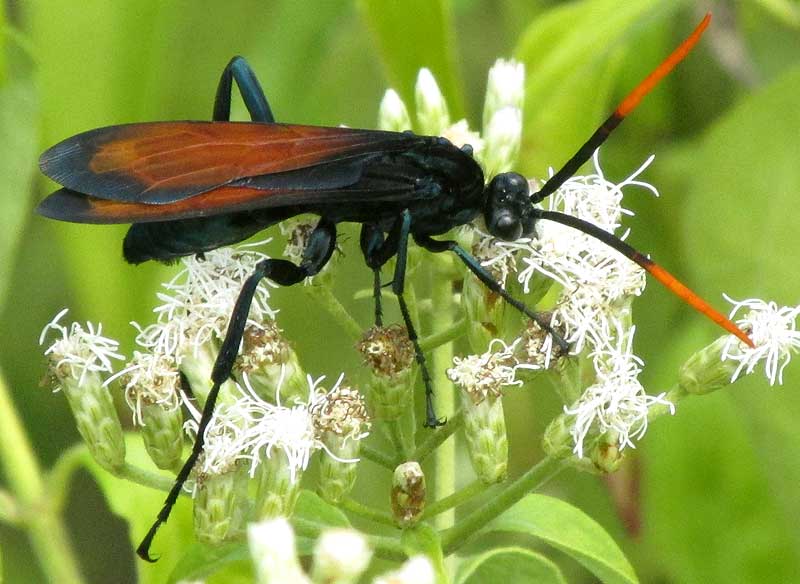Excerpts from Jim Conrad's
Naturalist Newsletter

from the December 28, 2014 Newsletter issued from Río Lagartos, on the Yucatan Peninsula's northern coast (~N21.60°, ~W88.16°), Yucatán state, MÉXICO
MILDE'S TARANTULA HAWK
Last week we looked at the all-black Mexican Tarantula Hawk, which is so big that often birders confuse it with a hummingbird. That was Pepsis mexicana, and you can see it and read about it at www.backyardnature.net/yucatan/hawkwasp.htm.
In these parts, that's the most commonly seen tarantula hawk species. This week a second tarantula hawk species allowed itself to be photographed It's of about the same size as the Mexican Tarantula Hawk and also looks like a hummingbird when it flies, but this new one is easily distinguished form the Mexican by its orangish wings and antennae. Above, you can see one feeding atop flowers of the eupatorium-like bush Chromolaena laevigata.
This one sometimes is called Milde's Tarantula Hawk. It's PEPSIS MILDEI, distributed from the arid US southwestern states south throughout Mexico to Panama. In our area you see about one Milde's Tarantula Hawk for every five Mexican ones. I've only seen this species zipping through the air with its long legs dangling behind, looking like a long-tailed hummingbird, and feeding on nectar and pollen, and those behaviors are identical to what the Mexican normally does.
Its tarantula-hunting habits are the same, too. When an adult female is ready to lay an egg, she locates a tarantula by smell, possibly having to enter the tarantula's burrow to drag it out, and then the wasp may need to wrestle with the tarantula until it can deliver a sting. The sting paralyzes the tarantula almost immediately, and the tarantula stays paralyzed for the rest of its sad life. The paralyzed tarantula is dragged into a burrow the wasp has dug into the ground, the wasp lays her egg on the tarantula, and the underground nest is sealed. When the egg hatches, the tiny larva immediately begins feeding on the tarantula, which remains alive, but paralyzed, until the final stages of the larva's growth.
Tarantula hawk wasps also sting humans, and their stings are regarded as among the most painful of all insect stings. However, they're not dangerous unless there's a special sensitivity. The wasps aren't aggressive toward humans, though, and sting only when aggressively provoked.